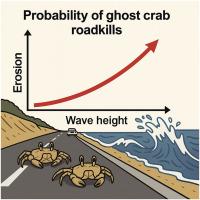道路死亡对沿海动物的威胁:巴西东南部的一个案例研究
IF 2.6
3区 地球科学
Q1 MARINE & FRESHWATER BIOLOGY
引用次数: 0
摘要
动物碰撞是道路对生物多样性影响的关键指标。然而,现有的道路死亡易感性记录和预测主要集中在大型内陆道路和陆生物种上,忽视了其对各种生态系统和沿海动物的更广泛影响。本研究的目的是评估空间和时间因素是否影响巴西东南部沿海公路上动物被公路撞死的风险。从2021年8月到2024年1月,对这条道路进行了大约8公里的监控。在夜间使用时速为20公里的车辆在路上搜寻动物。每次动物遭遇都以地理位置为参考,以测量基于卫星的变量,包括城市化水平、人工照明、海岸线树木覆盖率、海滩宽度、海岸线退缩趋势、潮汐范围、气温、降水和浪高。此次共发现负鼠9只、鸟类6只、蛇3只、蝙蝠1只、海龟幼崽47只、鬼蟹184只等250只动物。根据二项分布的广义线性模型,在受侵蚀影响较大的地区和风暴潮事件期间,鬼蟹被道路杀死的风险显著增加。这些结果提供的证据表明,沿海道路死亡加剧了避难所栖息地的丧失,这是沿海挤压现象的一个关键特征。为了尽量减少沿海道路上的野生动物碰撞,建议在风暴期间关闭道路,主要是在受侵蚀影响的地区,建造野生动物过境点,安装表明动物存在的标志,并在该地区实施公众意识项目。本文章由计算机程序翻译,如有差异,请以英文原文为准。

Coastal fauna under threat from roadkills: A case study in southeastern Brazil
Animal collisions serve as key indicators of the impacts of roads on biodiversity. However, existing records and predictions of roadkill susceptibility predominantly focus on large inland roads and terrestrial species, overlooking its broader impacts on diverse ecosystems and coastal fauna. The objective of this study was to evaluate whether spatial and temporal factors influence the risk of animals being road-killed on a coastal road in Southeastern Brazil. The road was monitored from August 2021 to January 2024 over a stretch of approximately 8 km. The search for animals on the road was conducted at night using a vehicle traveling at ∼20 km/h. Each animal encounter was georeferenced to measure satellite-based variables including the level of urbanization, artificial light, shoreline tree coverage, beach width, coastline retreat tendency, tide range, air temperature, precipitation, and wave height. A total of 250 animals were found, including nine opossums, six birds, three snakes, one bat, 47 sea turtle hatchlings, and 184 ghost crabs. According to the Generalized Linear Model with binomial distribution, the risk of ghost crabs being road-killed was significantly higher in areas more affected by erosion, and during storm wave events. These results provide evidence that coastal roadkills are intensified by the loss of refuge habitats, a key characteristic of the coastal squeeze phenomenon. To minimize wildlife collisions on coastal roads, it is recommended to close roads during storms mainly in areas affected by erosion, build wildlife crossings, install signs indicating the presence of fauna, and implement public awareness programs in the region.
求助全文
通过发布文献求助,成功后即可免费获取论文全文。
去求助
来源期刊
CiteScore
5.60
自引率
7.10%
发文量
374
审稿时长
9 months
期刊介绍:
Estuarine, Coastal and Shelf Science is an international multidisciplinary journal devoted to the analysis of saline water phenomena ranging from the outer edge of the continental shelf to the upper limits of the tidal zone. The journal provides a unique forum, unifying the multidisciplinary approaches to the study of the oceanography of estuaries, coastal zones, and continental shelf seas. It features original research papers, review papers and short communications treating such disciplines as zoology, botany, geology, sedimentology, physical oceanography.

 求助内容:
求助内容: 应助结果提醒方式:
应助结果提醒方式:


